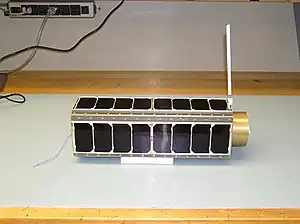 The GeneSat-1 satellite. | |
| Mission type | Technology demonstration Bioscience |
|---|---|
| Operator | NASA |
| COSPAR ID | 2006-058C |
| SATCAT no. | 29655 |
| Mission duration | 21 days (planned) |
| Spacecraft properties | |
| Spacecraft type | CubeSat |
| Bus | 3U CubeSat |
| Manufacturer | Ames Research Center Stanford University |
| Launch mass | 4.6 kg (10 lb) |
| Dimensions | 10 cm × 10 cm × 34 cm (3.9 in × 3.9 in × 13.4 in) |
| Power | 4.5 watts |
| Start of mission | |
| Launch date | 16 December 2006, 12:00:00 UTC |
| Rocket | Minotaur 1 |
| Launch site | MARS, LP-0B |
| Contractor | Orbital Sciences Corporation |
| Entered service | 16 December 2010 |
| End of mission | |
| Decay date | 4 August 2010 |
| Orbital parameters | |
| Reference system | Geocentric orbit |
| Regime | Low Earth orbit |
| Perigee altitude | 413 km (257 mi) |
| Apogee altitude | 420 km (260 mi) |
| Inclination | 40.0° |
| Period | 92.9 minutes |
GeneSat-1 is a NASA fully automated, CubeSat spaceflight system that provides life support for bacteria E. Coli K-12. The system was launched into orbit on 16 December 2006, from Wallops Flight Facility.[1] GeneSat-1 began to transmit data on its first pass over the mission's California ground station.
The nanosatellite[2] contains onboard micro-laboratory systems such as sensors and optical systems that can detect proteins that are the products of specific genetic activity. Knowledge gained from GeneSat-1 is intended to aid scientific understanding of how spaceflight affects the human body.[3]
Weighing 4.6 kilograms, the miniature laboratory was a secondary payload on an Air Force four-stage Minotaur 1 launch vehicle that delivered the Air Force TacSat-2 satellite to orbit. In the development of the GeneSat satellite class (at a fraction of what it normally costs to conduct a mission in space), Ames Research Center (Small Spacecraft Office) collaborated with organisations in industry and also universities local to the center. It is NASA's first fully automated, self-contained biological spaceflight experiment on a satellite of its size.
References
- ↑ "Mission Overview: GeneSat-1". National Aeronautics and Space Administration. Retrieved 28 November 2011.
 This article incorporates text from this source, which is in the public domain.
This article incorporates text from this source, which is in the public domain. - ↑ David, Leonard (30 August 2005). "GeneSat-1: Small Satellite Tackles Big Biology Questions". Space.com. Retrieved 28 November 2011.
- ↑ "GeneSat 1". NASA. 21 October 2021. Retrieved 25 October 2021.
 This article incorporates text from this source, which is in the public domain.
This article incorporates text from this source, which is in the public domain.
External links
- A list from the NASA database retrieved 08:55(UTC) 24 October 2011
- GeneSat-1 mission dashboard Santa Clara University Robotics Systems Laboratory retrieved 08:19 24.10.2011